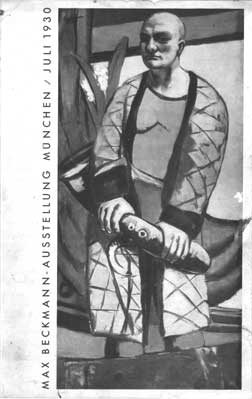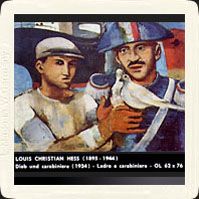|
(dma)
- The first phase of the project to rediscover Hess'
work was opened by circulating the two monograph albums among
potentially interested parties in Italy, Germany and Austria. This
helped make the project better known but now it was necessary to
restore the paintings - literally to make them visible - make them
ready for exhibition and put them before the scrutiny of the critics
in order to build up support and approval. These phases on the road
to the final destination seemed to find favour from the stars. For
example my meeting with the painter Lionel Fioravanti Massa, the
last heir of the great impressionist masters, whom I interviewed for
Radio Rai in the summer of 1971 when the city council in Messina
paid him tribute with a major exhibition at Palazzo Zanca.
|
 |
|
Max
Beckmann
as seen in a painting by Hess |
|
 |
|
IThe
brochure presenting the exhibition of Max Beckmann's
Parisian works at the Graphisches Kabinett in Munich in
the summer of 1930. It includes one of Beckmann's most
well-known self-portraits. Next to it "The Chess-player"
by Christian Hess - Oil on canvas 94 x 71cms (Munich
1931) - which bears a strong resemblance to Hess' close
friend Beckmann.
|
I took the opportunity to speak to him about the project to rediscover
Hess' work and made the surprising discovery that Massa - born in Genoa
but who had German nationality - had met Hess in 1930 in Munich where he
had gone to see an exhibition by Max Beckmann. He also knew that the two
artists were friends, but not that Hess had portrayed Beckmann in the
now famous painting "The Chess-player", today part of the collection of
the Museum of Modern Art in Bolzano. Massa and me immediately got on
well together. We went to Emma's house in via Simeto to see the
paintings. Among her brother's papers Emma found a brochure for the
Beckmann exhibition mentioned by Massa. It had been held in early July
1930 at the Graphisches Kabinett, Briennerstrasse 10 and was the very
first showing for the works which Beckmann had painted in Paris.
According to the brochure, the exhibition had been made possible "thanks
to the bequests and loans by Prof. Curt Glaser of Berlin, Dr Raemisch of
Krefeld, Baron von Simolin of Munich, as well as the J.B. Neumann
Gallery of New York and A. Flechtheim of Berlin.” The Munich
exhibition lasted around three weeks because at the beginning of August
the paintings joined the major Beckmann exhibitions at the Kunsthalle in
Basle and the Kunsthaus in Zurich. Although 41 years had passed since
the Munich exhibition, that brochure brought Massa's memories alive
again and he recognised Hess in the photographs which Emma showed him.
Then with great care he began examining the paintings and was in no
doubt that they were by the Maestro he himself had known.
|
Before and after Restoration |
|
Some examples of the restoration
work on Hess' paintings.
Click on the thumbnails |
|
|
|
Canvasses painted on both sides |
|
|
Massa was also certain that
despite the wear and tear suffered by the paintings during their wartime
travels, they could be successfully restored. He suggested the work be
carried out at the Rome workshop of Everardo Pavia, in via Margutta,
next to the “Galerie de Paris” where Massa had a permanent
exhibition. I began organising the restoration with Nuccio Cinquegrani
who in the meantime had begun working as a freelance journalist. I was
based in Palermo and he in Messina, a fact that without doubt helped the
promotional campaign for the Rediscovery as it helped build up
contacts with institutions and art collectors. When the
restored paintings were returned to Messina a suitable location was
needed for their preview showing to art experts and the press.
Unfortunately Emma's house in via Simeto was old, damp and cramped and
stuck out in the suburbs. And here again fate stepped in with another
lucky coincidence: an apartment in a new building, perched on a hill
with a splendid view, which Emma had been waiting to move into had just
been completed. It seemed as if some mysterious hand
 were moving all the
pieces in the right places. The house looked out on the magical panorama
of the Straits of
Messina, the same view which had so inspired so many of Hess' paintings.
The newly restored paintings were again photographed by Venero Dominici
- in part as material for the archive, in part to help promote the
rediscovery project. Emma's new apartment was just below the penthouse.
We would carry the paintings out onto the terrace in the early afternoon
when the light was at its best and continue until dusk made work
impossible. In those weeks we worked with untiring enthusiasm. Dominici
used a pair of Rolleiflex 6x6. Each painting was photographed on black
and white and colour stock and on Kodachrome for colour slides. The best
slides were to be used for a
slide show as part of the promotional campaign. I decided to
boost the effectiveness of the slides by adding captions in Italian and
German and including the measurements of the paintings. These were
produced on film - in negative - at a local printworks. were moving all the
pieces in the right places. The house looked out on the magical panorama
of the Straits of
Messina, the same view which had so inspired so many of Hess' paintings.
The newly restored paintings were again photographed by Venero Dominici
- in part as material for the archive, in part to help promote the
rediscovery project. Emma's new apartment was just below the penthouse.
We would carry the paintings out onto the terrace in the early afternoon
when the light was at its best and continue until dusk made work
impossible. In those weeks we worked with untiring enthusiasm. Dominici
used a pair of Rolleiflex 6x6. Each painting was photographed on black
and white and colour stock and on Kodachrome for colour slides. The best
slides were to be used for a
slide show as part of the promotional campaign. I decided to
boost the effectiveness of the slides by adding captions in Italian and
German and including the measurements of the paintings. These were
produced on film - in negative - at a local printworks.
|
The "Gallery" which launched the
Rediscovery |
|
 |
Once photography
was finished, the restored paintings - including
those on loan from collectors - were displayed on
the walls of the lounge and the other reception
rooms in Emma's new apartment. This extraordinary
and impromptu "gallery" provided a welcoming
location for the visit of critics, journalists and
representatives of institutions and cultural
organisations. The pictures of the paintings on the
walls -
click to see
- offer various views of the collection which helped
to attract support and sponsorship for the
Rediscovery of Christian Hess' work.
|
I then had to cut out each
caption and apply it to the bottom of the slide. In this way I made the
captions for some 80 slides - complete paintings and details - which
were then placed in three “magazin 77” cases produced by
“Rollei-Werke Franke & Heidecke Braunschweig” ready for slide shows to
art critics, gallery owners, public institutions and the press. At the
time - the early 1970's - this method was considered quite advanced and
without doubt it served to boost the promotional campaign which had
begun with two simple monographs illustrated with documents, archive
photos and pictures of the as yet unrestored paintings.
|